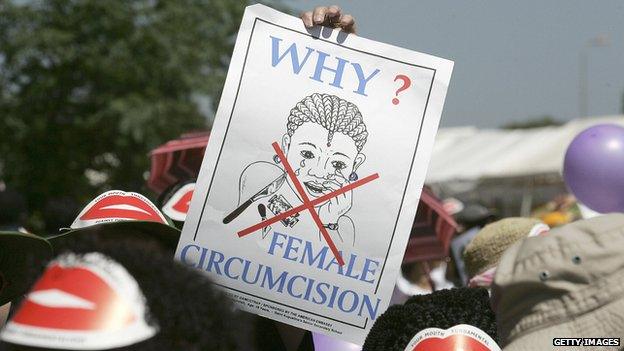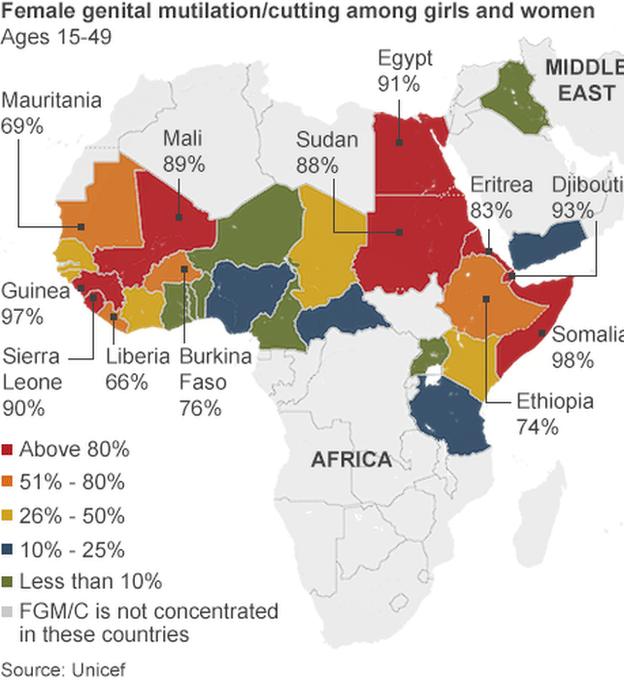FGM: What is female genital mutilation? Debunking the myths
- Published

Warning this report contains graphic descriptions of the practices involved in female genital mutilation.
Female genital mutilation, or FGM, is when a girl's genitals are either partially or totally removed for non-medical reasons.
Sometimes called female circumcision, it dates back around 2,500 years.
It affects 130 million girls and young women worldwide, but there's still a lot of myths and misinformation surrounding female genital mutilation.
Myth 1: It doesn't happen in the UK

FGM is practised in around 30 countries, largely across Africa and the Middle East.
Unicef say in places like Egypt and Somalia over 90% of girls and women have been cut.
But the numbers of newly identified cases in the UK is growing.
A report released last summer by City University London said there are thought to be around 137,000 women living consequences of female genital mutilation in England and Wales, with another 60,000 at risk.
Last week the Health and Social Care Information Centre (HSCIC) revealed there'd been 558 newly identified cases of FGM reported by hospitals across England in December 2014.
That's around 18 new cases a day.
In reality though that number is likely to be higher, as 26 NHS trusts didn't submit figures to the HSCIC.
Myth 2: It's always done for religious reasons

FGM is carried out for a number of cultural, religious and social reasons.
Although it's not in any religious texts, for some communities the practise has become symbolic as a demonstration of faith.
In most societies though FGM is considered a cultural tradition, associated with ideals of femininity and modesty.
This includes the idea that girls are "clean" and "beautiful" after removal of body parts that are considered "male" or "unclean".
It's also often motivated by beliefs around what is considered "proper sexual behaviour".
Many believe it reduces a woman's sex drive and therefore stops them from having sex before marriage.
The covering or narrowing of the vagina's opening is also expected to further discourage "illicit" sexual intercourse by women later in life.
Myth 3: It's done for health reasons

According to the World Health Organisation, the NHS and many more organisations there are no health benefits to FGM.
In fact it can cause both short and long-term health problems.
Some of the immediate effects include: severe pain, bleeding, wound infection, open sores, inability to pass urine and damage to other organs, such as the urethra (where urine passes) and the bowel.
Longer term the practise can cause abnormal periods, difficulty passing urine, kidney failure, infertility, cysts, pain during sex and the need for later surgery to open the vagina for sexual intercourse and childbirth.
Myth 4: It's the same as male circumcision

Male circumcision is the surgical removal of the foreskin from the penis.
It's usually performed on babies and young boys and is common practice in the Jewish and Islamic faiths.
Female genital mutilation is when a girl's genitals are either partially or totally removed for non-medical reasons.
In most cases it's carried out on girls under 15, by traditional circumcisers or preachers.
The practise is often performed using thorns, broken glass or razor blades, and without anaesthetic.
There are several types of FGM.
Clitoridectomy involves removing part or all of the clitoris.
Excision is the removal of part or all of the clitoris and the lips that surround the vagina, with or without removal of the larger outer lips.
Infibulation is the most severe form of FGM.
In this instance the outer lips and clitoris are removed, then the genitals are stitched closed so that the woman either cannot have or enjoy having sex.
A tiny piece of wood or reed is inserted to leave a small opening, so the girl can still go to the toilet and have her period.
If she gets pregnant she'll be unstitched for the birth and then sewn back up again afterwards.
Other types of FGM include pricking, piercing, incising and scraping the genital area.
Follow @BBCNewsbeat, external on Twitter, BBCNewsbeat, external on Instagram and Radio1Newsbeat, external on YouTube